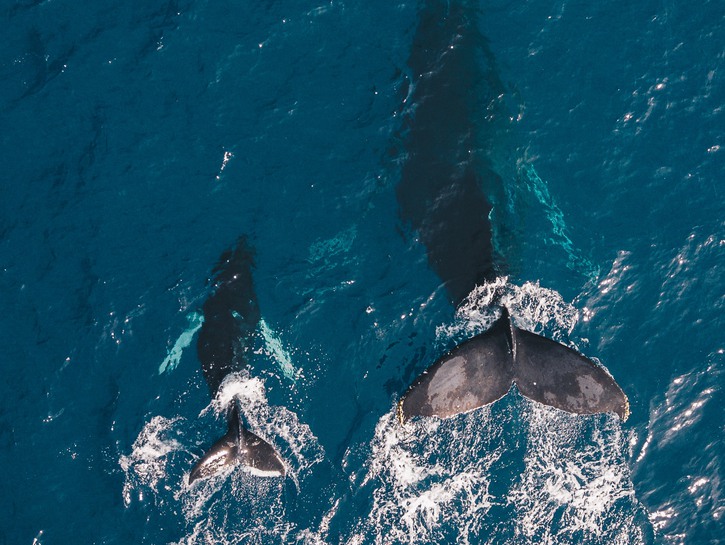
There’s something otherworldly and indescribable about witnessing an enormous whale explode out of the water and crash back down onto the sea’s surface. These gargantuan creatures are intimidating yet breathtaking at the same time. They’re the type of animals that make us humans realize how small we really are in this world.
Videos by TravelAwaits
Whale-watching is an experience that brings us closer to a species we rarely get to encounter. North America has some of the world’s best whale-watching opportunities — not just in Canada and the United States, but also in Mexico.
Listed below are the places in these three countries that offer you the best chance of spotting your own Free Willy, and information about how to embark on your own whale of an adventure.
Best Whale-Watching Spots In Canada
1. British Columbia
Orcas, humpback whales, minkes, and gray whales abound in British Columbia, particularly in Vancouver, Richmond, and Victoria. Rich with marine life, the waters off the coast of BC allow travelers to get up close and personal with these majestic maritime mammals, an experience like no other.
March through October are the best months to partake in whale-watching in BC, and BC Whale Tours offer an abundance of tours fit for every type of traveler.
Best for young children and seniors, BC Luna’s vessel has a luxurious design and the highest safety rating in the whale-watching industry.
Prospective photographers and filmmakers will want to hop on the BC Tika, an outdoor-seating only vessel that has been chartered out by numerous film and documentary crews.
2. Quebec
May through October is Québec’s ideal whale-watching season, with opportunities to gaze upon 13 different species of cetaceans found mainly in the waters of the St. Lawrence, including humpback and blue whales, the largest animals on the planet. If you’re lucky enough, you can even spot humpbacks from the shore. These impressive animals tend to swim up to the mouth of Saguenay Fjord National Park near Tadoussac.
Québec’s Whale Watching Essipit Cruise offers travelers the unique experience of sailing directly at water level in inflatable zodiac vessels along the St. Lawrence Estuary, the largest estuary in the world. On this tour, visitors can abut with humpbacks, blue whales, fin whales, seals, and minkes.
3. Nova Scotia
Canada’s picturesque province of Nova Scotia welcomes 12 species of whales during the summer and fall months, namely humpback, minke, fin, blue, pilot, sei, and North Atlantic right whales. These awe-inspiring creatures grace the waters of Nova Scotia’s Cape Breton Island, the Bay of Fundy, and Brier Island.
In Westport, Brier Island Whale and Seabird Cruises are dedicated not only to offering unparalleled whale-watching experiences, but also collecting important information on endangered or rare species of whales. A portion of whale-watch sales on these particular cruises is contributed to the company’s ongoing research.

Whale-watching in Vancouver, British Columbia. Unsplash / Luc Tribolet
Best Whale-Watching Locations In The United States
1. Massachusetts
According to the World Wildlife Fund, Massachusetts is one of the top ten whale-watching destinations in the world. From April to October, the state’s Stellwagen Bank National Marine Sanctuary invites visitors to indulge in bona fide New England whale-watching expeditions alongside onboard naturalists.
Departing from Cape Cod, Hyannis Whale Watcher Cruises have been in business for over thirty years and have a 99% sighting rate. The company’s state-of-the-art jet-powered vessel takes visitors through some of the world’s best whale-watching waters for the chance to spot humpback, finback, and minke whales, and at times, large numbers of Atlantic white-sided dolphins.
2. Alaska
With Kenai Fjords National Park being Alaska’s top whale-watching destination, the most copious species in this area are humpback and orca whales, while gray whales can be seen in the Gulf of Alaska during their annual migration season in the spring.
Kenai Fjords Tours claims that their whale-watching tours are an adventure of both patience and adrenaline. Passionate and knowledgeable captains and deckhands guide visitors through a journey observing humpback and orca whales that are often seen in pods breaching, playfully slapping their fins, bubble-net feeding, and showing off their flukes.
Other prominent whale-watching tours in Alaska are Major Marine Tours, Gastineau Guiding, and Northern Latitude Adventures. Considering whale watching on an Alaska cruise? Here’s what to know.
4. Hawaii
From November to May, Hawaiian waters are graced by humpback whales, or as Hawaiians call them, kohola. With peak season running from January to March, whale-watching is an activity that is gaining more popularity throughout the islands due to its abundance of these magnificent mammals.
For only $31 USD, Maui Watch Whale Cruise takes guests on a two-hour excursion with the guarantee of a whale-spotting. Travelers get an exciting peek into this underwater world, including informative narration from the captain and crew. Stunning views and photo opportunities proliferate on this tour along Maui’s captivating coastline.

Provincetown, Massachusetts. Unsplash / Thomas Kelley
Best Whale-Watching Locations In Mexico
1. Cabo San Lucas
Mid-January to Mid-March is the best time for whale-watching in Cabo San Lucas, when the bay of the same name welcomes humpback and gray whales along its coastline.
Because they migrate along Mexico’s Baja Coast to calve, gray whales are seen most frequently in Cabo San Lucas, though humpbacks, sperm whales, blue whales, and orcas can also be spotted.
Receiving a Certificate of Excellence from TripAdvisor for five consecutive years, Cabo Trek‘s staff delivers excellent and responsible services — plus the best whale-watching to be had in Cabo San Lucas. From December until April, travelers can embark on a whale-watching tour with Cabo Trek and take a look into the natural habitat of humpback, California gray, and blue whales.
2. San Ignacio
With whales so close you can sometimes even reach out and touch them, San Ignacio boasts an abundance of these gentle giants set in the natural beauty of a lagoon.
This Baja California region is home to Kuyimá Eco-Lodge, a whale camp offering a four-day adventure that includes three fully-guided whale-watching boat tours and afternoon nature-watching activities. The tour’s vessels are safe 23 to 25-foot outboard-motor boats called pangas, operated by experienced skiff drivers.
For a detailed depiction of this particular whale-watching tour, check out this article.
3. Nayarit
Sayulita and Rincón de Guayabitos are two areas in Nayarit that offer the best whale-watching experiences.
A quaint surfer town with a hippie vibe, Sayulita is best for whale-watching from November to April. Situated at the meeting point of the North Pacific Ocean, Sea of Cortez, and the Tropical Eastern Pacific, this biogeographic location is centered in a marine transition zone, making it an ideal location to witness a wide diversity of marine life, especially whales and dolphins.
Check out Ally Cat Sailing Adventures for whale-watching tours in Sayulita that include sailing, snorkeling, fishing gear, and paddleboards.
Located just a 30-minute drive from Nayarit, Rincón de Guayabitos is best for whale-watching from December to March. This quiet seaside town is nestled between the Sierra Madre Occidental Mountains and the Pacific Ocean, with a famous humpback whale migration providing ample whale-watching opportunities and three native species of endangered sea turtles.

Cabo San Lucas, Mexico. Unsplash / frank mckenna
We hope this article has inspired you to plan a whale-watching expedition of your own. There’s no better way to experience the kinship between all living things, no matter how different. Happy trails!


